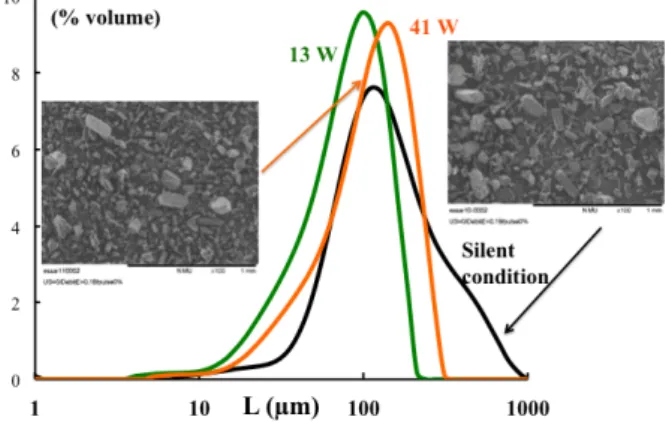HAL Id: hal-01773847
https://hal.archives-ouvertes.fr/hal-01773847
Submitted on 31 Jan 2019HAL is a multi-disciplinary open access archive for the deposit and dissemination of sci-entific research documents, whether they are pub-lished or not. The documents may come from teaching and research institutions in France or abroad, or from public or private research centers.
L’archive ouverte pluridisciplinaire HAL, est destinée au dépôt et à la diffusion de documents scientifiques de niveau recherche, publiés ou non, émanant des établissements d’enseignement et de recherche français ou étrangers, des laboratoires publics ou privés.
Crystallization of α-glycine by anti-solvent assisted by
ultrasound
Hector Rodriguez Vera, Fabien Baillon, Philippe Accart, Fabienne Espitalier,
Olivier Louisnard
To cite this version:
Hector Rodriguez Vera, Fabien Baillon, Philippe Accart, Fabienne Espitalier, Olivier Louisnard. Crys-tallization of α-glycine by anti-solvent assisted by ultrasound. 16th Meeting of European Society of Sonochemistry (ESS16), Apr 2018, Besançon, France. �hal-01773847�
Crystallization of α-glycine by anti-solvent assisted by ultrasound
Hector Uriel RODRIGUEZ VERA1, Fabien BAILLON1,Philippe ACCART1, Fabienne ESPITALIER1*, Olivier LOUISNARD1
1Université de Toulouse, Mines Albi, CNRS, Centre RAPSODEE, Campus Jarlard, F-81013 Albi CT cedex 09, France.
Introduction
In this work, we studied the crystallization of α−glycine by addition of an anti-solvent (ethanol) assisted by ultrasound. The glycine is an amino acid presenting three polymorphs: α−glycine, γ−glycine and β-glycine. At room temperature, the γ−glycine is the most stable [1, 2]. It is soluble in the water and insoluble in ethanol. Previous works on cooling crystallization of glycine with ultrasound in aqueous phase showed that a purer crystalline phase with moderate power is formed with more regular faces [3] and a decrease of the induction time when the ultrasonic power increases [4].
Materials and Methods
Pure α−glycine is used for experiments (VWR CHEMICALS, 99,9 % purity). The experiments of crystallization are conducted in a solution of 150 ml shaken by a magnetic rod. A solution of concentration 0.26 kg α−glycine / kg water is prepared at 35 °C (5 °C above the temperature of saturation). This solution is then cooled at 30 °C (temperature close to the temperature of saturation of the initial solution). The ultrasound is then applied to various powers thanks to a plunging transmitter (generator Bioblock, 20 kHz). Once the temperature is stabilized at 30 °C, ethanol is added at a constant flow rate by means of a syringe pump. The addition rate varies between 0.04 in 0.36 g of ethanol/min. The measurement of refractive index of solution permits to follow the concentration of glycine Cglycine during the experiment.
The supersaturation ratio (S) is calculated by the ratio of C and Cα−glycine,eq. Cα−glycine,eq
is the equilibrium concentration of α−glycine measured for this study. At the end of the experiments, the suspension is filtered, the solid washed with ethanol and dried at 60 °C. The final crystals are characterized by their final size distributions measured by laser granulometry, their morphologies observed by scanning electronic microscope (SEM) and their crystalline structures by differential scanning calorimetry (DSC). The influence of ultrasonic power (continuous or pulsed modes) measured by calorimetry method is studied for different addition rates. The maximal supersaturation ratio Smax and the induction time (time between S = 1 and Smax, Fig.1)
are observed.
Results and Conclusion
Analysis by DSC with a heating rate of 5 °C/min between 20 and 200 °C show no endotherm of transformation of α−glycine towards γ−glycine [1]. This means that pure metastable α-form is obtained whatever the operating conditions. A decrease of induction time and of Smax is observed in the presence of ultrasound (Fig. 1).
Figure 1. Supersaturation ratio as function of time for experiment conducted with an addition rate of 0.19 g ethanol/min in silent condition or with ultrasound (13, and 40 W)
In presence of ultrasound, smaller crystals with a monomodal size distribution are obtained at the end of the crystallization (final supersaturation ratio equal to 1). The rate of de-supersaturation is higher in presence of ultrasound inducing a higher nucleation rate or a higher growth rate or both. From experimental results, modeling of crystallization will permit to conclude on crystallization rates.
Figure 2. Size distributions of final crystals for experiment conducted with an addition rate of 0.19 g ethanol/min in silent condition or with ultrasound (13 and 40 W)
The use of pulsed ultrasound (50 one/50 off) seems to be interesting because similar results are obtained: same size distributions and same concentration profiles.
References
[1] Yang, X., Ching, C. B., Wang, X. J. & Lu, J., Polymorphism in the crystallization of glycin. AICHE
annual meeting, San Fransisco, CA, 2006.
[2] El Bazi W., Porte C., Mabille I. et al. Journal of Crystal Growth, 475, 232-238. 2017.
[3] Louhikultanen, M., Karjalainen, M., Rantanen, J. et al. International Journal of Pharmaceutics, 320 23–29. 2006
[4] Baillon, F., Espitalier F., Cogné C., et al. Power ultrasonics: Applications of high intensity ultrasound,
chapter 28. 845-874. 2014.
